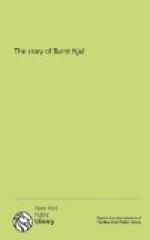It was just then, just when the unflinching will of Harold had taught this stern lesson to his old foes, and arising in most part out of that lesson, that the great rush of settlers to Iceland took place. We have already seen that Ingolf and others had settled in Iceland from 874 downwards, but it was not until nearly twenty years afterwards that the island began to be thickly peopled. More than half of the names of the first colonists contained in the venerable Landnama Book—the Book of Lots, the Doomsday of Iceland, and far livelier reading than that of the Conqueror—are those of Northmen who had been before settled in the British Isles. Our own country then was the great stepping-stone between Norway and Iceland; and this one fact is enough to account for the close connection which the Icelanders ever afterwards kept up with their kinsmen who had remained behind in the islands of the west....
SUPERSTITIONS OF THE RACE.
The Northman had many superstitions. He believed in good giants and bad giants, in dark elves and bright elves, in superhuman beings who tilled the wide gulf which existed between himself and the gods. He believed, too, in wraiths and fetches and guardian spirits, who followed particular persons, and belonged to certain families—a belief which seems to have sprung from the habit of regarding body and soul as two distinct beings, which at certain times took each a separate bodily shape. Sometimes the guardian spirit or fylgja took a human shape; at others its form took that of some animal fancied to foreshadow the character of the man to whom it belonged. Thus it becomes a bear, a wolf, an ox, and even a fox, in men. The fylgjur of women were fond of taking the shape of swans. To see one’s own fylgja was unlucky, and often a sign that a man was “fey,” or death-doomed. So, when Thord Freedmanson tells Njal that he sees the goat wallowing in its gore in the “town” of Bergthorsknoll, the foresighted man tells him that he has seen his own fylgja, and that he must be doomed to die. Finer and nobler natures often saw the guardian spirits of others. Thus Njal saw the fylgjur of Gunnar’s enemies, which gave him no rest the livelong night, and his weird feeling is soon confirmed by the news brought by his shepherd. From the fylgja of the individual it was easy to rise to the still more abstract notion of the guardian spirits of a family, who sometimes, if a great change in the house is about to begin, even show themselves as hurtful to some member of the house. He believed also that some men had more than one shape; that they could either take the shapes of animals, as bears or wolves, and so work mischief; or that, without undergoing bodily change, an access of rage and strength came over them, and move especially towards night, which made them more than a match for ordinary men. Such men were called hamrammir, “shape-strong,” and it was remarked that when the fit left them they were weaker than they had been before.




